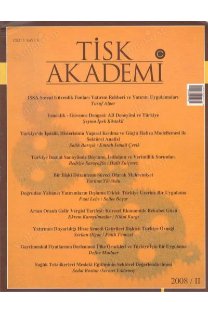Optimal Para Alanı Teorisi Çerçevesinde Avrupa Para Birliği'nin Değerlendirmesi
The Evaluation of the European Monetary Union from the Perspective of Optimum Currency Area Theory
___
- Adams, P.D. (2005), “Optimal Currency Areas: Theory and Evidence for an African Single Currency” University of Manchester, September.
- Aktan, H.O. (1983), Para Birlikleri Kuramı ve Avrupa Para Sistemi, Hacettepe Üniversitesi İktisadi ve İdari Bilimler Fakültesi Yayınları, No:4, Ankara.
- Bini-Smaghi, L.; Silvia V. (1992), Rating the EC as an Optimal Currency Area: Is It Worse Than The US?, Mimeo. Roma: Banca d'Italia.
- Birinci, Y. (2001), Euro’nun Uluslararası Finansal Piyasalar ve Türkiye Ekonomisi Üzerindeki Etkileri, İstanbul, Alfa Yayınları: 959, Dizisi No:78, 1.Baskı.
- De Grauwe, P. (1993), The Economics of Monetary Integration, Oxford University Pres.
- ECB Working Paper (2002), New Views on the Optimum Currency Area Theory: What is EMU Telling Us, No:138.
- Eichengreen, B. (1997), European Monetary Unification: Theory, Practice, and Analysis, The MIT Press, Cambridge Mass.
- Erdönmez, P.A. (2004), “Avrupa Birliği Finansal Entegrasyon Sürecinde Bankacılık Sektörü”, Bankacılar Dergisi, Sayı (50): 68-84.
- Frankel, J.A. ve Rose, A.K. (1997), “The Endogeneity of the Optimum Currency Area Criteria”, NBER Working Papers, 5700, Revised Draft.
- Fukuda, H. (2002), The Theory of Optimum Currency Areas: An Introductory Survey, Faculty of Economics, Keio University Mita Festival paper.
- IMF Working Paper (1997), A Model Of An Optimum Currency Area, Prepared By Luca A. Ricci, June.
- Ingram, J. C. (1969), “Comment: The Currency Area Problem”, in “Monetary Problems of the International Economy”, Mundell, Alexander & Swoboda eds., University of Chicago Press.
- İKV Yayınları (2000), Avrupa Birliği’nde Ekonomik ve Parasal Birlik ve Türkiye, No:163, Ekim, İstanbul.
- Kar, M. (2003), Avrupa Birliği ve Ortak Para Politikası, (Avrupa Birliği Ortak Politikalar ve Türkiye. Ed. M. Kar ve H. Arı kan) İstanbul, Beta Yayınları, İşletme Ekonomisi Dizisi 124, Yayın No: (1406): 177-216.
- Karluk, R. (2002), Uluslararası Ekonomi Teorisi ve Politika, Yayın No:1243, İşletme Ekonomi Dizisi 99, 6. Baskı, İstanbul, Beta Yayınları.
- Kenen, P.B. (2002), “What We Can Learn from the Theory Of Optimum Currency Areas”, Submissions on EMU From Leading Academics, EMU Study, December, 147-160.
- Kenen, P.B. (1969), “The Theory of Optimum Currency Areas: An Eclectik View”, (in (Ed) R.A., Mundell; A.K Swobodo), Monetary Problems in the International Economy, University of Chicago Press, 41-60.
- Krugman, P. (1993), “Lessons of Massachusetts for EMU” In Francisco Torres, and Francesco Giavazzi (eds.) Adjustment and Growth in the European Monetary Union, 241-269.
- Maes, I. (1992), “Optimum Currency Area Theory and European Monetary Integration”, Tijdschrift voor Economie en Management, Vol.XXXVII, (2): 37-152.
- Mckinnon, J.A. (1963), “Optimum Currency Areas”, in: American Economic Review, III, No:(4): 717-725.
- Mulhearn, C. (2004), “Beyond ‘Euroland’: British Trade Unions, The Single Currency And European İntegration”, Industrial Relations Journal, Blackwell Publishing, (35:4): 296-310.
- Mumcu, M. (2005), “Avrupa Birliği’nde Finansal Hizmetler Politikası (2005- 2010)”, Bankacılar Dergisi, Sayı (55): 88-92.
- Mundell, R.A. (1961), “The Theory of Optimum Currency Areas”, in:The American Economic Review, (53): 657-665.
- Pomfret, R. (2005), “Currency Areas in Theory and Practice”, The Economic Record, June, Vol. 81, No (253): 166–176.
- Pricewaterhousecoopers (2006), Managing Mobility Matters.
- Savaş, V. (1999), Çağımızın Deneyi Euro, İstanbul, Siyasal Kitapevi.
- Tavlas, G.S. (1993), “The Theory of Optimum Currency Area Reviseted”, Finance and Development/June 1993: 32-35.
- Tavlas, G.S. (1997), “The International Use of the US Dollar: An Optimum Currency Area Perspective”. The World Economy 20 (6): 709-747.
- Tower, E.; Willet, T.D. (1976), “The Theory of Optimum Currency Areas and Exchange Rate Flexibility”, Special Papers in International Economics 11: May 1976.
- Tur, O. (2000), Avrupa Para Birliği ve Sermaye Hareketlerinin Serbestleştirilmesi, Beta Yayınları, Yayın No: 945, İşletme Ekonomi Dizisi:100, İstanbul.
- Varol, K. (2004), Avrupa Birliği’nde Finansal Entegrasyona Çok Az Kaldı,Activeline Gazetesi 01.09.2004, No 54: 1-8.
- Willett T. ve Tower E. (1970), “The Concept of Optimum Currency Areas and the Choice Between Fixed and Şexible Exchange Rates”, Halm G., ed., Approaches to Greater Şexibility of Exchange Rates, (Princeton University Press): 407-415.
- Yüceol, H.M. (2004), “Optimal Para Alanı Teorisi Üzerine Bir Değerlendirme: Teori, Uygulama ve Politika”, Pivolka, 3(12): 3-6.
- ISSN: 1306-6757
- Yayın Aralığı: 2
- Başlangıç: 2006
- Yayıncı: Türkiye Isveren Sendikalari Konfederasyonu
Avrupa Birliği'nde Sosyal İçerme Politikaları
Avrupa Birliği Hukukunda İşverenin İşçilere Bilgi Verme ve Danışma Yükümlülüğü
Osmanlı İmparatorluğu'ndan Türkiye Cumhuriyeti'ne Emeğin Serüveni
Örgütlerde Üretkenlik Karşıtı İş Davranışları: Belirleyicileri ve Önlenmesi
Ağ Ekonomisine Dönüşümde Rekabet Politikasında Yaşanan Değişim
Optimal Para Alanı Teorisi Çerçevesinde Avrupa Para Birliği'nin Değerlendirmesi
Saygın ŞAHİNÖZ, Atabek DEMİRHAN, Erdoğan COŞAR
5510 Sayılı Kanun, Anayasa Mahkemesi'nin İptal Kararı ve Çatırdayan Norm ve Standart Birliği
5510 Sayılı Kanun, Anayasa Mahkemesi'nin İptal Kararı ve Çatırdayan Norm ve Standart Birliği
